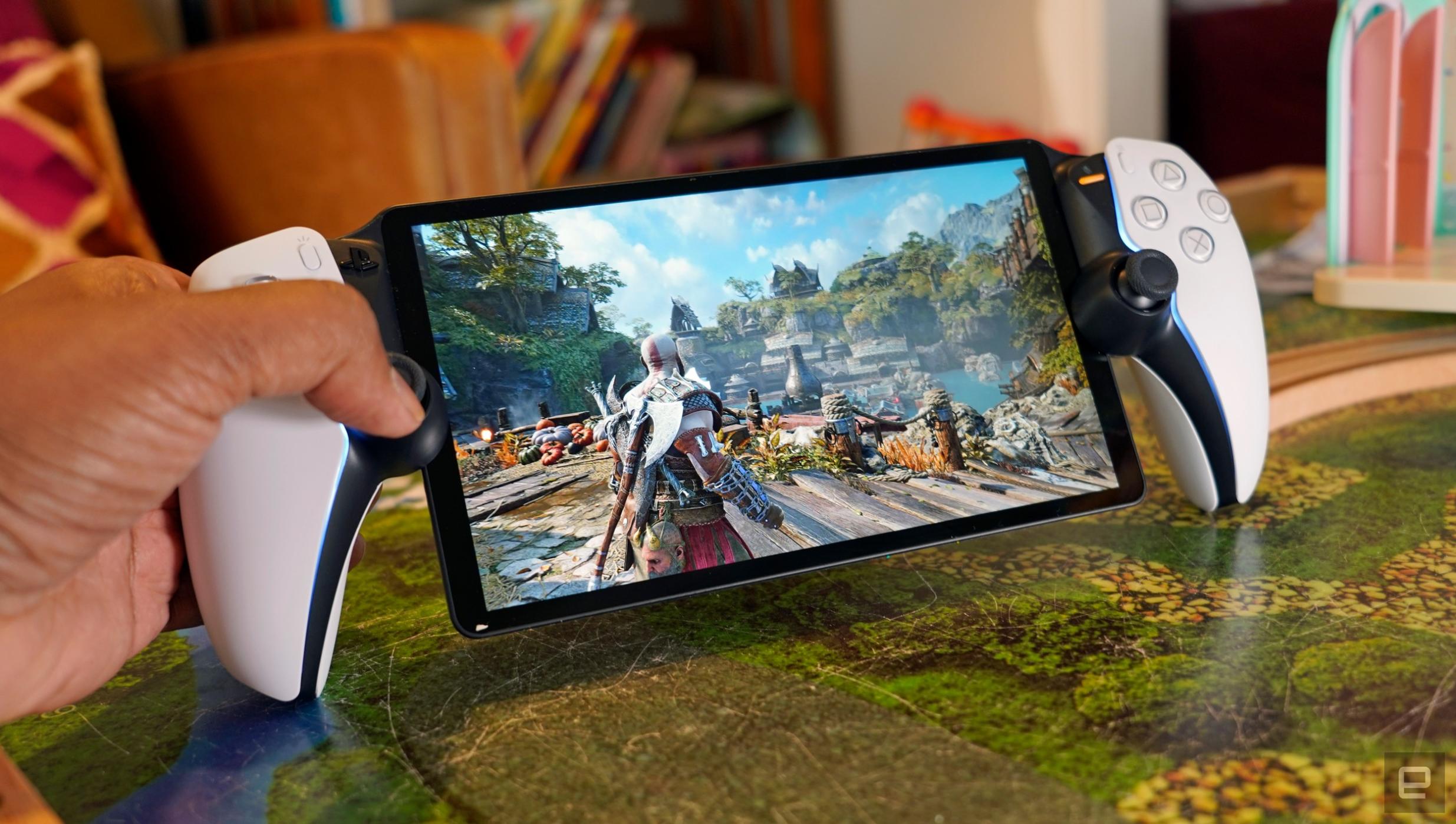Sony just released PlayStation Portal (November 15, 2023), a handheld accessory designed to provide remote access to PS5 games. Initial impressions of the Portal are mixed but mostly positive. The quirky design takes some getting used to, but the overall package shows promise as an affordable supplementary device for PS5 owners.
First Impressions of the PlayStation Portal
Straight out of the box, the Portal looks a bit odd with its wide, chonky body and short, stubby handles. Setup is fairly quick if your PS5 system software is up to date. Otherwise, expect a lengthier process of updating the Portal and your console before syncing them up.
Once connected, the Portal offers a seamless extension of the PS5 gaming experience. Visually demanding titles run smoothly, with no noticeable lag or performance issues. The 8-inch LED screen is crisp with deep blacks, though glare can be a problem in bright lighting.
How the Portal Stacks Up to Other Handhelds
Compared to the Nintendo Switch, the Portal has a smaller game library since you can only access PS5 titles. But its integration with a home console provides more robust graphics and processing power in a portable form factor.
| Feature/Aspect | PlayStation Portal | Nintendo Switch | Steam Deck |
|---|---|---|---|
| Primary Function | Remote play device for PS5 games | Standalone handheld and home console | Handheld gaming PC |
| Screen Size & Type | 8-inch LCD HD | 6.2-inch (original) / 7-inch (OLED) LCD | 7-inch LCD |
| Game Library | PS5 games via remote play | Nintendo game library, third-party titles | PC games, extensive Steam library |
| Price (approx.) | $200 | $300 (original) / $350 (OLED) | $399 – $649 (depending on model) |
| Portability | Highly portable, Wi-Fi dependent | Highly portable, no Wi-Fi needed for offline play | Highly portable, no Wi-Fi needed for offline play |
| Controls | DualSense features integrated | Joy-Con controllers, detachable | Built-in gamepad controls |
| Connectivity | Wi-Fi for remote play, PlayStation Link | Wi-Fi, Bluetooth | Wi-Fi, Bluetooth |
| Battery Life | Dependent on usage, not specified | 4.5 – 9 hours depending on model | 2 – 8 hours depending on usage |
| Special Features | Adaptive triggers, haptic feedback | Detachable Joy-Cons, TV dock mode | Customizable controls, touchpad |
| Compatibility | PS5 only | Nintendo Switch games | Compatible with most PC games |
| Additional Functionality | Access to PS5’s menus and screen streaming | Handheld and docked TV modes, local multiplayer | Access to PC software, web browsing, media streaming |
The Steam Deck is arguably the Portal’s closest competition. But Valve’s device is a standalone portable system, while the Portal relies entirely on connection to a PS5. The Portal’s lower $199 price point helps offset this limitation.
For mobile gaming, the Portal provides a much larger screen and seamless controller integration compared to phone accessories like the Backbone controller.
The Pros and Cons of Portal’s Connection to the PS5
Requiring a PS5 console enables the Portal to match the performance of a premium home gaming rig in your hands. No game downloads or accounts needed – just directly stream from your existing library.
The downside is that both devices must be powered on and connected to access games. The Portal doesn’t yet allow game streaming if your PS5 is offline or in use by someone else.
Sony would be wise to add offline gameplay support and simultaneous streaming in future software updates. For now, the tether to your console means the Portal works best as an in-home supplementary device.
Here is a table breaking down the full list of pros and cons of the Playstation Portal:
| Pros | Cons |
|---|---|
| Remote Play Capability: Enables playing PS5 games without a TV, offering flexibility in gaming locations. | Dependence on Wi-Fi: Requires a stable Wi-Fi connection for optimal performance, which can be limiting. |
| Handheld Convenience: Compact and portable, allowing gaming on the go within Wi-Fi range. | Price: At around $200, it can be considered an additional expense on top of the PS5 console. |
| Advanced Features: Incorporates adaptive triggers, haptic feedback, and lossless audio for an immersive experience. | Limited to PS5: Only compatible with PS5, not useful for those without the console or with other gaming systems. |
| Integrated DualSense Features: Offers a seamless experience with all the buttons and features of a PS5 DualSense controller. | Screen Size Limitations: The 8-inch screen might not be ideal for all games or players accustomed to larger displays. |
| High-Quality Screen: 8-inch LCD HD screen provides clear and vibrant visuals. | Battery Life: As a handheld device, battery life might be a concern during long gaming sessions. |
| Enhanced Connectivity: Uses PlayStation Link technology for a stable and efficient connection to the PS5. |
Putting the Hardware to the Test
In terms of sheer performance, the Portal delivers. Games run smoothly at up to 60fps, with excellent image quality on par with the PS5. Battery life is around 6 hours for intensive 3D games.
The smaller handles take minor adjustment, but overall ergonomics remain comfortable for extended play sessions. The matte exterior resists fingerprints. My only complaint is the glossy screen prone to glare.
Responsiveness is excellent, with seamless remote connections and minimal lag. One brief disconnection occurred during several days of testing, but reconnecting took seconds.
The Games That Shine (and Struggle) on the Small Screen
Visually simple 2D indie games like Sifu and cinematic story-driven titles like God of War Ragnarök play beautifully on the Portal’s 8-inch display. Text and interface elements remain crisp and legible.
More cluttered HUDs in games like Final Fantasy XVI prove challenging to decipher on the smaller screen. And the Portal’s touchpad navigation needs refinement to avoid accidentally activating menus and features.
Overall, the Portal shines when playing games designed for cinematic presentation over dense UI. Focusing on art and animation over interface complexity enhances the handheld experience.
Navigating Menus and Controls
The Portal replicates the DualSense controller layout faithfully, including analog sticks, shoulder buttons, and action buttons. The exceptions are the smaller handles and the touchscreen substituting the touchpad.
This touchscreen is both a pro and a con. It enables quick finger taps to activate menus and options. But poor tip integration means you’ll likely stumble into unintended commands until you adjust.
Thankfully the core controls perform admirably. And it shouldn’t take Sony too much effort to refine the touch interface and add a dedicated Portal settings menu to streamline navigation.
Multiplayer, Remote Play, and Account Access
Since it streams directly from your PS5, the Portal can access all the same multiplayer servers, online networks, and PSN account features. Remote play with a paired controller also works smoothly.
The catch remains that you can’t use these features unless your PS5 is also turned on and you’re logged in. Sony limits the Portal to act as a wireless extension rather than standalone portable.
Adding support for cloud game streaming when the PS5 is offline or in use would significantly boost the Portal’s appeal and value.
Recommendations for Software Improvements
Along with remote offline access, better touchscreen integration and a Portal settings menu could refine the experience. An OLED display option would also help minimize glare issues.
Optimizing games to better present text and UI on the smaller screen will maximize playability. Sony should incentivize developers to fine-tune readability for handheld modes.
Most importantly, allowing simultaneous PS5 and Portal access would enable true console-handheld flexibility. Here’s hoping Sony adds this missing puzzle piece soon.
Is Portal Worthwhile for Casual and Serious Gamers?
For hardcore gamers invested in the PS5 ecosystem, the Portal is a no-brainer buy if Sony adds offline/simultaneous support. Casual gamers may want to wait until the Portal can operate independently of the console.
Given its limitations compared to the Steam Deck, the Portal’s $199 MSRP seems fair. But improving remote access and adding an OLED display option could make this handheld a must-have accessory.
As a secondary gaming screen for PS5 owners, the Portal has enormous potential. Addressing its software-based restrictions will determine if Sony’s handheld experiment pays off.
The Verdict: A Promising but Still Evolving Portable
There’s a lot to like in a portable package designed to mirror the PS5 experience. The Portal’s big, beautiful screen and seamless integration deserve praise. But its dependence on the console holds it back – for now, at least.
As a supplementary device, the Portal nails the basics. With smart software improvements, it could evolve into every PlayStation gamer’s dream handheld. For tech-savvy early adopters, it’s a sneak peek at an exciting work in progress.






